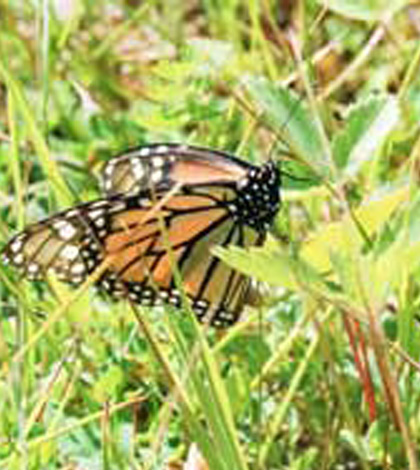Recent sightings lead Dr. Joe Shorthouse to believe there’s still hope
MANITOULIN—In most summers, monarch butterflies are a common sight on Manitoulin Island from late June to early September. The large brown, black and white butterflies with their gliding flight patterns grace our gardens and pastures where they feed on the nectar of many flowers.
Likewise, the brightly-coloured caterpillars with their characteristic bands of black, yellow and white, which announce that they are nasty tasting, are commonly found feeding on milkweed.
However, 2013 has proven to be different as something has happened to cause the monarch’s populations to crash and as a result, the adult butterflies so far this year are a rare sight on Manitoulin Island.
I have been checking patches of milkweed at sites such as the sand dunes at Providence Bay each week since early June where adults and caterpillars have been common in previous years. As of July 21, I had not seen a single adult or caterpillar.
I was about to give up on finding monarchs on Manitoulin in 2013 when on Tuesday, July 23, I was walking in the tall grasses of the alvar above Bay Estates and to my delight, I flushed three adults from the dense vegetation.
It was windy on Tuesday afternoon with the grasses and milkweed whipping back and forth in the strong gusts. Amazingly, two of the adult females I flushed chose to fly directly into the wind as they quickly searched for sheltered spots to rest or milkweed flowers to feed on nectar. Two of the females I flushed were faded and their wings were tattered, but they were still strong fliers.
The fact that monarchs even make it to Manitoulin as one of their most northern destinations is amazing as they likely had to fly across Lake Huron to get here. They either flew up the Upper Peninsula of Michigan and then across Lake Huron, or flew across Lake Erie, up the Bruce Peninsula and then across Lake Huron to make it to our southern shores.
The appearance of these three butterflies—and hopefully there are many more—is even more spectacular when one considers the events that got them here.
In contrast to migrating birds, the monarchs that overwinter in Mexico start looking for milkweed to lay their eggs soon after they begin the long flight north. The offspring of these monarchs continue flying north and they also lay eggs relying on new butterflies to complete the trip to Manitoulin.
This means that the Manitoulin monarchs raised in the summer of 2012 were the great-great-grandparents of the butterflies I found on Tuesday. How such a small insect can make it to Mexico from Manitoulin and then rely on its offspring to return the following year remains one of the greatest mysteries of our natural world.
Monarch butterflies are one of the world’s most spectacular migrators. Each fall, adults that have been bred in southeastern Canada and northern USA, fly to central Mexico where millions spend the winter hanging on trees found on a single mountain top.
Hopefully, more adult monarchs made it to Manitoulin in the past week or so, in addition to the three I saw on Tuesday. However, they will have to lay their eggs quickly and the caterpillars will have to be exposed to warm weather if they are to turn into adults and successfully avoid the cool temperatures of fall.
Researchers and citizen scientists throughout the US and southern Canada have noted that populations of monarchs are much smaller in 2013 than in previous years. There were only 60 million monarchs wintering in Mexico last winter, well below the usual average of 350 million. The area of forest covered with monarchs was only three acres this past winter, compared to the 17-acre average.
The unusually cold temperatures across the middle section of the US this spring are thought to have contributed to the delayed northward migration.
Even more concerning is the steady loss of milkweed—the only food of monarch caterpillars—in row crops such as corn and soybeans due to the adoption of seed varieties genetically modified to tolerate treatment with herbicides. Growing herbicide-tolerant crops results in the use of more herbicides leading to the elimination of milkweed in many parts of the US.
Intensive farming that reduces habitat for natural plants between the edge of roads to the fields and management of roadsides with the use of herbicides, along with excessive mowing, has hindered the growth of milkweed.
By arriving late this season across their northern breeding range, there is concern that monarchs will produce fewer offspring, resulting in a small fall migration and low numbers in Mexico again this coming winter.
However, monarchs have a high reproductive potential and can produce a new generation in about 30 days. Thus if the weather on Manitoulin cooperates, our area will be able to contribute individuals ready to fly to Mexico this fall.
I have yet to see a caterpillar on the Island. If you find one, perhaps you could leave a message at my camp telephone (705-368-0504) describing the locality. If you are interested in monarchs, be sure and see the IMAX film “Flight of the Butterflies” which is currently playing at Science North in Sudbury.
This film follows the career of Dr. Fred A. Urquhart of the University of Toronto who devoted his life to finding the overwinter site of monarch butterflies and unraveling the secrets of their migration. Also, check out Monarch Watch at www.monarchwatch.org.
Dr. Joe Shorthouse is an Emeritus Professor of Entomology at Laurentian University and a summer resident at Batman’s Campground near Sheguiandah and travels throughout Manitoulin Island studying and photographing natural history. See his work at http://manitoulinnaturalhistory.com/index.html.
Dr. Joe D. Shorthouse




